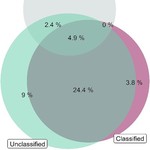Abstract
To identify areas of high biodiversity and prioritize conservation efforts, it is crucial to understand the drivers of species richness patterns and their scale dependence. While classified land cover products are commonly used to explain bird species richness, recent studies suggest that unclassified remote-sensed images can provide equally good or better results. In our study, we aimed to investigate whether unclassified multispectral data from Landsat 8 can replace image classification for bird diversity modeling. Moreover, we also tested the Spectral Variability Hypothesis.
Using the Atlas of Breeding Birds in the Czech Republic 2014-2017, we modeled species richness at two spatial resolutions of approx. 131 km2 (large squares) and 8 km2 (small squares). As predictors of the richness, we assessed 1) classified land cover data (Corine Land Cover 2018 database), 2) spectral heterogeneity (computed in three ways) and landscape composition derived from unclassified remote-sensed reflectance and vegetation indices. Furthermore, we integrated information about the landscape types (expressed by the most prevalent land cover class) into models based on unclassified remote-sensed data to investigate whether the landscape type plays a role in explaining bird species richness.
We found that unclassified remote-sensed data, particularly spectral heterogeneity metrics, were better predictors of bird species richness than classified land cover data. The best results were achieved by models that included interactions between the unclassified data and landscape types, indicating that relationships between bird diversity and spectral heterogeneity vary across landscape types.
Our findings demonstrate that spectral heterogeneity derived from unclassified multispectral data is effective for assessing bird diversity across the Czech Republic. When explaining bird species richness, it is important to account for the type of landscape and carefully consider the significance of the chosen spatial scale.
